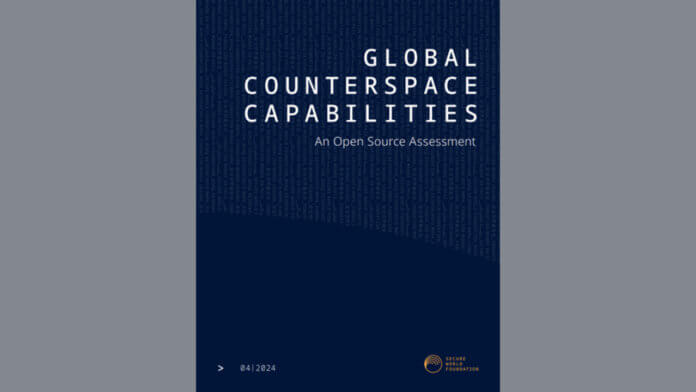
A recent report on global counterspace capabilities details space electronic warfare efforts ongoing around the world.
The publication of the Secure World Foundation’s (SWF) annual Global Counterspace Capabilities report is an eagerly-awaited event in the Armada office. The SWF “envisions the secure, sustainable and peaceful uses of outer space contributing to global stability and benefits on Earth” in the organisation’s own words. Global Counterspace Capabilities has been published annually by the foundation since 2018. Co-edited by Brian Weedon and Victoria Samson, the report “assesses the current and near-term future (counterspace) capabilities” for each country under the report’s purview.
United States
Of particular interest are the report’s findings regarding counterspace Electronic Warfare (EW) capabilities. Broadly speaking, the report notes that the People’s Republic of China (PRC), Russia and the United States have, or are pursuing, significant EW capabilities with applicability to the space domain. Australia, the Democratic People’s Republic of Korea (DPRK), France, India, the Islamic Republic of Iran, Israel, Japan, the Republic of Korea (ROK) and the United Kingdom are pursuing similar capabilities in some shape or form.
US space EW capabilities are assessed as having enjoyed significant research, development and testing in recent years, and to have been used operationally in conflict. Most notable of these capabilities is the L3Harris Counterspace Communications System (CCS). The CCS is the only acknowledged offensive counterspace capability of the United States and is used to attack Satellite Communications (SATCOM) receivers. Australia is moving forward with a purchase of a single CCS example from the US. The report also cites counter Global Navigation Satellite System (GNSS) technology being developed in the US to attack Position, Navigation and Timing (PNT) signals.
Russia
Russia has accrued significant space EW research, development and testing experience, and has deployed counter-space electronic warfare capabilities operationally. Several Armada articles have chronicled counter-space EW systems in operational use with the Russian military. The report warns that the Russian government “may be developing high-powered space-based EW platforms to augment its existing ground-based platforms.” Eventual deployment of these systems dovetails with wider Russian strategic, operational and tactical doctrines. “Russian military thinkers see modern warfare as a struggle over information dominance and net-centric operations that can often take place in domains without clear boundaries and contiguous operating areas.” The report’s authors say that “Russia is pursuing lofty goals of incorporating EW capabilities throughout its military to both protect its own space-enabled capabilities and degrade or deny those capabilities to its adversary.” From a research and development perspective, one capability Russia is believed to be interested is “high-powered space-based EW platforms.”
The PRC and India
PRC space EW capabilities are more mysterious with research, development and testing underway although no operational deployment is believed to have occurred: “Chinese military doctrine places a heavy emphasis on electronic warfare” as part of a broader information warfare posture. The PRC is said to be an enthusiastic user of GNSS jamming possessing both fixed and mobile systems. Some of these systems, the report continues, may have been deployed on Mischief Reef. The reef forms part of the Spratly Islands archipelago in the South China Sea. Possession of the archipelago is disputed by several regional actors. GNSS jamming has also been recorded in the vicinity of Shanghai on the East China Sea coast.
In contrast India is thought to be performing some space EW research, development and testing work. Indian Army EW systems like the Bharat Electronics Limited Himshakti, may jam SATCOM. Open sources say Himshakti can detect and jam emissions across a 500 megahertz/MHz to 40 gigahertz/GHz waveband. Australia, for her part, is moving ahead with Defence Project 9358. Launched in July 2021, this initiative is developing a ground-based, counter-space EW capability.
Middle East and Asia Pacific
Looking towards the Middle East both Iran and Israel are pursuing space EW research, development and testing. Whereas Israel’s space EW capabilities are thought to be operational it is less clear whether this is the case for Iran. The report does say that “Iran has demonstrated an EW capability to persistently interfere with the broadcast of commercial satellite signals.” Nonetheless, “its capacity to interfere with military signals is difficult to ascertain.” In October 2022, French television satellite operator Eutelsat accused the government of Iran of jamming two of its satellites. Such actions would suggest Iran can jam C-band (3.7GHz to 4.2GHz downlink) and Ku-band (10.9GHz to 12.75GHz downlink) terminals receiving signals in these wavebands from the Eutelsat constellation.
The government of Israel has been accused of jamming GNSS Position, Navigation and Timing (PNT) signals. Reports have said that Israel deploys PNT jamming to frustrate attacks using GNSS-guided weapons and uninhabited aerial vehicles launched against targets in the country from the Gaza Strip. The strip, on the eastern Mediterranean, was controlled the Hamas Islamist insurgent organisation. PNT jamming has been evident since Israel began operations in Gaza after the Hamas attacks of 7th October.
Asia-Pacific
The DPRK, Japan and the ROK are all developing counter-space EW capabilities, the former performing significant research in this regard. The DPRK has been noted as using GNSS jamming against civilian PNT signals in the vicinity of the Demilitarised Zone (DMZ). The DMZ is the de facto border between the DPRK and the Republic of Korea. As for the ROK, “the South Korean Air Force is working on EW counterspace capabilities that can be used to deter or counter adversary space capabilities.”
Ms. Samson says that counterspace EW is attractive to nations as ““kinetic and destructive counter-space weapons are just not usable.” Risks of uncontrolled and uncontrollable space debris, and potential political fallout, can make kinetic counter-space weapons hard to deploy, Ms. Samson observers. “Kinetic space weapons are a weapon of last resort.” Conversely, “jamming and cyber counterspace weapons are seen as very useful counterspace capabilities.” Unlike kinetic counterspace weapons where it may be relatively easy to determine the perpetrator, space electronic warfare can be harder to attribute: “Jamming is more feasible to use vis-à-vis kinetic counterspace weapons,” Ms. Samson adds. Space EW capabilities may also be comparatively less expensive to acquire and operate. Expect another Global Counterspace Capabilities report in 2025 with more useful space EW updates.

by Dr. Thomas Withington












